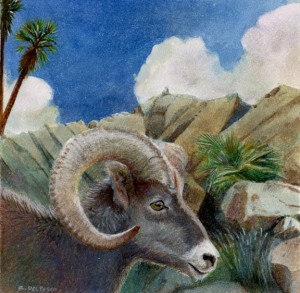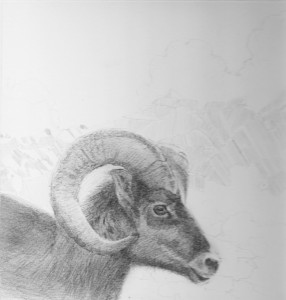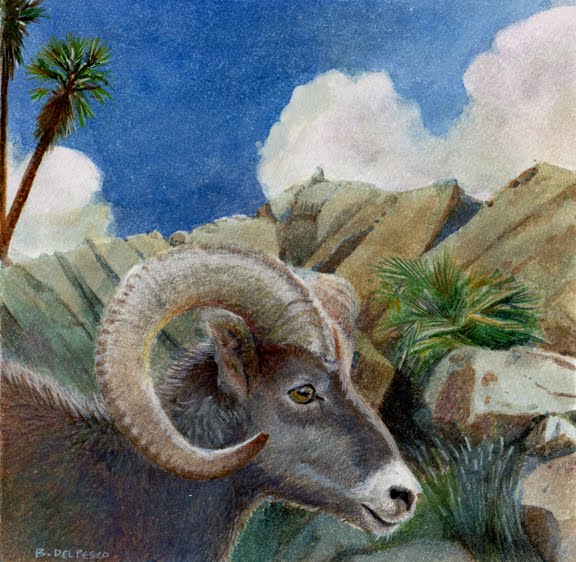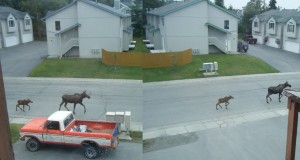 Ovis 7×6.75 Graphite & Watercolor
Ovis 7×6.75 Graphite & Watercolor
Sold
This little guy is almost finished, and he’s been fun to draw & paint this week. We’ve got house guests for the weekend, so I may not get to him till Monday. And then I’ve got his buddy – posted earlier – to paint as well, so I’ll post when he’s finished too. I love these animals. When my client sent me a photo of one of these sheep on a manicured lawn in Southern California, I was pretty amazed. And later, I remembered that while sitting at the kitchen table in my daughter’s apartment a few years ago in Anchorage, we saw a moose and her calf jog by! (See photo at the bottom of this post.) Where I live (the desert north of Los Angeles), we have coyotes, rabbits and lizards in the yard, so every region of the US probably has critters indigenous to the area stopping by to say Yo! while they scope out the hood. My client’s home just happens to have these amazmo big horned sheep.
 A few peeps left comments or wrote email asking about watercolor over graphite. I fin d that as long as the graphite is buffed into the paper with stomps, paper towel or q-tips – as part of the blending and smoothing process – it works fine as dry version of the grisaille method of under-painting. I use a light touch while brushing the wet pigments over the graphite, and I add one layer at a time in thin, transparent glazes. If you’ve never done it, and you’re curious, make a small, buffed sketch and try some washes over it. You can see this same approach: pencil drawing first, and then watercolor on top – in process shots from previous posts here and here and here.
A few peeps left comments or wrote email asking about watercolor over graphite. I fin d that as long as the graphite is buffed into the paper with stomps, paper towel or q-tips – as part of the blending and smoothing process – it works fine as dry version of the grisaille method of under-painting. I use a light touch while brushing the wet pigments over the graphite, and I add one layer at a time in thin, transparent glazes. If you’ve never done it, and you’re curious, make a small, buffed sketch and try some washes over it. You can see this same approach: pencil drawing first, and then watercolor on top – in process shots from previous posts here and here and here.
A winner! After all the names from the give away post were put into a bowl, twirled around like cake batter, and one little folded slip of paper was pulled from the pile, the winner of the book on Watercolor Still Life, the block of Canson Cold Pressed paper, and 14 tubes of Winsor Newton Cotman Series Watercolors is *Penny*!!! Congratulations, Penny! And hearty Thanks to everyone who participated in the contest. I’ve got more goodies coming, so stick around. 🙂
Art Quote
There are many worse preparations for the career of a painter than the work of a hack illustrator. The illustrator must be ready to draw anything and, if he takes his work seriously and does his tasks as well as he can, he is learning something every day. And he must concentrate his mind on his result, learn to tell his Story and to make his intention clear. No one is so little tempted to the modern fallacy that the only business of a painter is to learn to paint, that the subject is of no importance, and that, if only one is a trained speaker, it matters little whether or not one has anything to say. The illustrator must always say some* thing, whether he says it well or ill. He must make his picture, always, and a fresh picture each time, and his success will depend on the interest of the public in what he does, not on the approval by his fellows of the way in which he does it. Homer’s work in black and white was, for the most part, independent of any written text and he seems, generally, to have chosen his subjects for himself. They are very varied and, in the course of his work as an illustrator, he experimented with almost every kind of subject he after* wards made his own as well as with many that he never rendered in color. He did not attempt the ideal or the romantic, but anything that he could see he was ready to draw, dealing impartially with town and with country, and trying his hand at well dressed ladies and gentlemen as at barefoot boys and sun-bonneted girls. His first Adirondack studies, his first seashore pieces, his first deep-sea scenes, appeared in black and white. ~Winslow Homer by Kenyon Cox 1914



Thank you for addressing this peep’s question. I am – not understating it – fascinated. I visited all of your old posts, and then was kinda blown away (ok, not kinda) when I looked at the underpainting of the kitchen scene and compared it to the final – especially where the lights appeared in the floor and the curtain in the final product. I also read about the grisaille method. So this “illustrator” has learned something today. Thank you. Oh, and great sheep too. 🙂
What fun to watch your process, I had to go look at the other examples of course. My front yard visitors aren’t so exotic, raccoons, possums, and squirrels. They at least don’t eat my plants though!
He looks really nice. Can’t wait to see the other one done.
Thanks for sharing how you do it. I will have to try it.